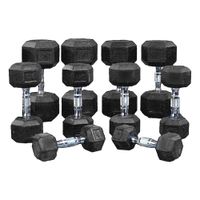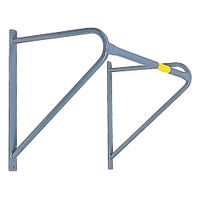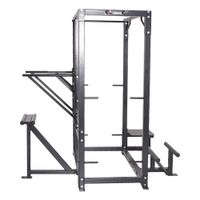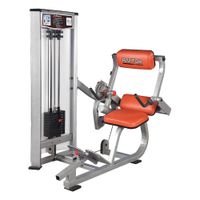Call +(254) 703 030 000 / 751 483 999 / 721 704 777
- Home
- Furnishings Appliances Hospitality
- Fitness Sports Recreation
- Exercise Equipment
- Strength Training Equipment
.....Read More
Frequently Asked Questions
What are the best free weights for home use?
The best free weights for home use depend on your fitness goals, space, and budget. Here are some top options:
1. **Dumbbells**: Versatile and essential for various exercises. Adjustable dumbbells save space and allow for easy weight changes. Brands like Bowflex and PowerBlock offer high-quality adjustable sets.
2. **Kettlebells**: Great for dynamic movements and full-body workouts. A set with varying weights (e.g., 10, 20, 30 lbs) can accommodate different exercises and fitness levels.
3. **Barbells and Weight Plates**: Ideal for strength training. An Olympic barbell with a set of plates (e.g., 2.5 to 45 lbs) is suitable for compound lifts like squats and deadlifts. Consider a barbell with a rack if space allows.
4. **Medicine Balls**: Useful for core workouts and functional training. A range of weights (e.g., 4 to 20 lbs) can enhance various exercises.
5. **Resistance Bands**: While not traditional weights, they offer resistance training benefits and are highly portable. They can complement free weights for a comprehensive workout.
6. **Weight Benches**: Though not weights, a sturdy bench enhances the utility of dumbbells and barbells, allowing for exercises like bench presses and rows.
7. **Sandbags**: Adjustable and versatile, they can be used for strength and conditioning exercises. They are also space-efficient and adaptable to different fitness levels.
When choosing free weights, consider durability, ease of use, and storage. Opt for equipment with a good grip and stable construction to ensure safety during workouts.
How do I choose the right squat rack for my needs?
1. **Space Availability**: Measure your workout area to ensure the squat rack fits comfortably. Consider ceiling height for overhead exercises.
2. **Type of Squat Rack**:
- **Power Rack**: Offers full cage design for safety and versatility.
- **Half Rack**: More compact, suitable for smaller spaces.
- **Squat Stand**: Basic and portable, but less stable.
3. **Weight Capacity**: Choose a rack that can handle more than your current lifting capacity to accommodate future strength gains.
4. **Safety Features**: Look for safety bars or spotter arms to catch the barbell if you fail a lift.
5. **Adjustability**: Ensure the rack has adjustable J-hooks and safety bars to accommodate different exercises and user heights.
6. **Build Quality**: Opt for a rack made from high-quality steel with a durable finish to withstand heavy use.
7. **Stability**: Check for a wide base and the option to bolt the rack to the floor for added stability.
8. **Attachments and Accessories**: Consider racks that offer additional features like pull-up bars, dip stations, or plate storage.
9. **Budget**: Determine your budget and compare options within that range, balancing cost with quality and features.
10. **Brand Reputation and Reviews**: Research brands known for quality and read user reviews for real-world performance insights.
11. **Warranty and Customer Support**: Look for a good warranty and reliable customer service for peace of mind.
12. **Future Needs**: Consider your long-term fitness goals and choose a rack that can grow with your training needs.
What is the difference between a weight bench and a squat rack?
A weight bench and a squat rack are both essential pieces of equipment in strength training, but they serve different purposes and have distinct features.
A weight bench is a versatile piece of equipment primarily used for exercises that involve lying, sitting, or leaning against a supportive surface. It typically consists of a padded bench that can be flat, inclined, or declined. The primary function of a weight bench is to support exercises like bench presses, dumbbell presses, flyes, and other upper body workouts. Some benches come with attachments for leg curls or preacher curls, enhancing their versatility. Weight benches are often used in conjunction with free weights like dumbbells and barbells.
On the other hand, a squat rack, also known as a power rack or power cage, is designed to support heavy lifting exercises, particularly those involving the lower body. It consists of a sturdy frame with adjustable safety bars and hooks to hold a barbell. The primary purpose of a squat rack is to facilitate exercises like squats, overhead presses, and deadlifts, providing safety and stability. The adjustable safety bars allow lifters to perform exercises without a spotter, as they can catch the barbell if the lifter fails a lift. Some squat racks also include pull-up bars and additional attachments for increased functionality.
In summary, the main difference lies in their design and purpose: a weight bench is primarily for upper body exercises and provides a supportive surface, while a squat rack is designed for heavy lifting, particularly for lower body exercises, offering safety and stability.
How do pull-up bars and dip stations improve upper body strength?
Pull-up bars and dip stations are effective tools for enhancing upper body strength by targeting multiple muscle groups through compound exercises.
Pull-up bars primarily engage the latissimus dorsi, biceps, and forearms. When performing pull-ups, the back muscles are activated to lift the body, while the biceps assist in the pulling motion. This exercise also engages the core for stabilization, promoting overall upper body strength and endurance. Variations like chin-ups can shift the focus more towards the biceps and chest, allowing for balanced muscle development.
Dip stations target the triceps, chest, and shoulders. During dips, the triceps are the primary movers, pushing the body upward. The chest muscles, particularly the pectorals, are engaged as the arms extend, while the anterior deltoids in the shoulders stabilize the movement. This exercise also recruits the core for balance, enhancing overall upper body coordination and strength.
Both pull-ups and dips are bodyweight exercises, which improve functional strength by mimicking natural movements. They enhance muscle endurance, increase muscle mass, and improve joint stability. Regular practice can lead to improved posture, as these exercises strengthen the muscles responsible for maintaining an upright position.
Incorporating variations and progressive overload, such as weighted pull-ups or dips, can further enhance strength gains. These exercises also promote neuromuscular efficiency, improving the body's ability to recruit muscle fibers effectively.
Overall, pull-up bars and dip stations provide a versatile and efficient means to build upper body strength, improve muscle tone, and enhance physical performance.
What are the benefits of using strength-training machines?
Strength-training machines offer several benefits:
1. **Safety**: Machines provide a controlled environment, reducing the risk of injury by guiding movements and supporting proper form, especially for beginners.
2. **Ease of Use**: They are user-friendly, often with clear instructions and adjustable settings, making them accessible for individuals with varying levels of experience.
3. **Isolation of Muscles**: Machines allow for targeted muscle training, isolating specific muscles or muscle groups, which is beneficial for rehabilitation or focused strength development.
4. **Stability**: They offer stability and support, which is advantageous for those with balance issues or when performing exercises that require heavy weights.
5. **Progress Tracking**: Machines often have weight stacks with incremental adjustments, making it easy to track progress and gradually increase resistance.
6. **Time Efficiency**: Switching between exercises is quick and straightforward, allowing for efficient workouts, especially in circuit training.
7. **Reduced Need for Spotters**: Machines eliminate the need for a spotter, providing confidence to lift heavier weights without assistance.
8. **Variety**: They offer a wide range of exercises targeting different muscle groups, contributing to a comprehensive workout routine.
9. **Rehabilitation**: Machines are often used in physical therapy settings to safely rebuild strength and mobility after injury.
10. **Consistency**: They ensure consistent movement patterns, which can help in developing muscle memory and improving technique.
11. **Accessibility**: Suitable for all fitness levels, from beginners to advanced users, and beneficial for older adults or those with physical limitations.
12. **Reduced Impact**: Machines often provide low-impact options, minimizing stress on joints and reducing the risk of overuse injuries.
How should I organize my weights on storage racks?
1. **Categorize by Type**: Group weights by type, such as dumbbells, kettlebells, weight plates, and barbells. This makes it easier to find and access the specific equipment you need.
2. **Arrange by Weight**: Within each category, organize weights from lightest to heaviest. This helps in quickly identifying the desired weight and ensures a logical flow when increasing or decreasing weight during workouts.
3. **Use Labels**: Clearly label each section or shelf with the type and range of weights it holds. This aids in maintaining organization and helps others using the space to return items to their correct place.
4. **Prioritize Accessibility**: Place frequently used weights at eye level or within easy reach. Less commonly used or heavier weights can be stored on lower shelves to prevent injury when lifting them.
5. **Balance the Load**: Distribute weight evenly across the storage rack to prevent tipping or damage. Ensure the rack is sturdy and can support the total weight of all equipment.
6. **Consider Space Efficiency**: Use vertical storage solutions to maximize space. Wall-mounted racks or tiered shelving can help keep the floor clear and provide more room for movement.
7. **Safety First**: Ensure that the storage area is free from clutter and that weights are securely placed to prevent accidents. Regularly check the stability of racks and the condition of weights.
8. **Aesthetic Organization**: For a visually pleasing setup, consider color-coding weights or using matching storage racks. This can enhance the workout environment and motivate regular use.
9. **Regular Maintenance**: Periodically clean and inspect weights and racks for wear and tear. Reorganize as needed to accommodate new equipment or changes in workout routines.
What safety tips should I follow when using strength training equipment?
1. **Warm-Up Properly**: Engage in a 5-10 minute warm-up to increase blood flow and prepare muscles.
2. **Use Correct Form**: Maintain proper posture and technique to prevent injuries. Consult a trainer if unsure.
3. **Start with Light Weights**: Begin with manageable weights to master form before progressing to heavier loads.
4. **Use Spotters**: For exercises like bench presses, have a spotter to assist and ensure safety.
5. **Inspect Equipment**: Check for any damage or wear on equipment before use.
6. **Secure Weights**: Ensure weights are properly secured on bars to prevent slipping.
7. **Breathe Properly**: Exhale during exertion and inhale during release to maintain stability and oxygen flow.
8. **Avoid Overtraining**: Allow muscles to recover by not working the same muscle groups on consecutive days.
9. **Stay Hydrated**: Drink water before, during, and after workouts to maintain hydration.
10. **Wear Appropriate Attire**: Use proper footwear and clothing to ensure comfort and safety.
11. **Listen to Your Body**: Stop immediately if you feel pain or discomfort.
12. **Cool Down**: Finish with a cool-down session to help muscles recover and reduce soreness.
13. **Follow Gym Rules**: Adhere to gym policies and guidelines for equipment use.
14. **Use Safety Features**: Engage safety locks and pins on machines when available.
15. **Educate Yourself**: Understand how each piece of equipment works before use.
16. **Avoid Distractions**: Focus on your workout and avoid using phones or engaging in conversations.
17. **Clean Equipment**: Wipe down equipment after use to maintain hygiene and prevent the spread of germs.



